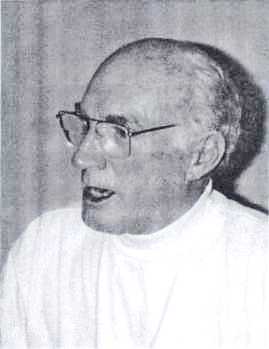Interests: Particle Physics, Quantum Theory
Richard Lincoln Ropiequet
Academic:
- University of Illinois: BS, chemistry major, 1946
- Navy: Electronics Technician Training, 1944-45
- Instructor SG radar: successive 2-week courses, 1945-46
- Post Grad, U of Wisconsin: psychology, summer 1949
Industry:
- Aluminum Ore Co., E. St. Louis, Ill: routine chemical analysis, 1941-42
- Douglas Aircraft, Santa Monica, CA & Oklahoma City, OK, 1942-44
Process engineer - chemical treatments, welding (arc, spot, & flash) - Firestone Plastics Co., Pottstown. PA, 1946-49
Product Development - formulating PVC for ease of electronic bonding, electrical-grade PVC, phonograph record molding resins - Tektronix, Inc, Portland, OR & Beaverton, OR, 1949-1963
Electronics circuit design: invented wide-range linear time base, dual-trace amplifier, automatic triggering, medical electronics. Advanced to Chief Engineer and V.P. of Engineering & CRT Research - Alta Industries, Inc., Beaverton & Portland, OR, Vancouver, WN, 1965-71
President & product inventor, plastics - loose-fill, drawer glides, novelties
My interest in learning how to visualize the structures of particles & nuclei began in 1936, during a high school chemistry course, when valences were being explained in terms of incomplete electron shells. Those numbers, 2-8-8-18-18-32, for complete shells, seemed to have no obvious rationale, especially when drawn as concentric rings of dots around the nucleus at the center. Surely there was some geometric explanation for these numbers, but my teacher didn?t offered any, and the textbook seemed uninterested in this puzzle! Later, in college courses, ingenious mathematical formulas, based upon Pauli?s Exclusion Principle, were offered to explain these numbers, but these seemed more like mnemonics, rather than explanations. This unsolved problem gnawed at my subconscious throughout my thirty-year career in industry, and I followed avidly the mushrooming activity in particle and nuclear physics in science periodicals and books, always hoping to find someone who considered the why questions of physics worthy of theoretical attention. And, as you might expect, finding no one!
My interest in Particle & Nuclear Physics was sharpened during my spell at Tektronix, Inc, where my work brought me in contact with Accelerator Engineers & Physicists and Nuclear Power & Bomb Physicists at the annual trade shows in New York, Chicago, Los Angeles / San Francisco & Dallas. As I progressed up the executive ladder, I was invited to visit the Berkeley Laboratory & Brookhaven Accelerators, and Arnold Engineering Labs, and was also invited to meet with physicists from Oak Ridge, Los Alamos, and Nevada test sites, in which conferences I learned about their goals & methods, and instrument needs.
Infinite Particle Physics began as a flash of insight while I was reading an article, "Photons as Hadrons", by Frederick V. Murphy and David E. Yount, in the July 1971 issue of Scientific American. This paper described experiments at the Stanford Linear Accelerator Center in which photons billions of times more energetic than visual-light photons were caused to strike targets of various metals from beryllium to uranium. Rather than being merely reflected or absorbed, these energetic photons occasionally reacted with the various atomic nuclei to produce large quantities of pions. This led the authors to speculate that perhaps high-energy photons took on a hadronic character, and transmogrified on collision with matter into vector mesons, which then decayed into pions within a few nuclear diameters. My reaction was that this interpretation, while clearly justified, missed an obvious point! Perhaps what had transmogrified was not the impinging photon, but, rather, space, itself! Perhaps space is composed of the "ingredients" of matter, and energy somehow rearranges these ingredients of space to produce matter. Perhaps matter is simply a pattern of distortion imposed upon the lattice of space, by the presence of lattice defects.
Here was the mental tickle from which this elaborate treatise has flowed. I was too innocent of the history of particle theory at that time to know that this idea was old-hat, having been advanced, and discarded, many times in the past. But it was new to me and tremendously stimulating! So much so, that I have spent all the years of my retirement since 1971 in hot pursuit of this mental tickle! I have outlined the way my theoretical ideas developed in the opening article of this website.


